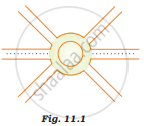Advertisements
Advertisements
प्रश्न
A light and a heavy object have the same momentum. Find out the ratio of their kinetic energies. Which one has larger kinetic energy?
उत्तर
Let m and M be the masses of light and a heavy object moving with velocities v and V respectively.
As both have the same momentum,
∴ mv = MV
or `"M"/"V'` .........(i)
The kinetic energy of a light object,
`"K"_"m" = 1/2 "mv"^2`
The kinetic energy of a heavy object,
`"K"_"m' = 1/2 "mV"^2`
The kinetic energy of a heavy object,
`"K"_"M" = 1/2 "MV"^2`
∴ `("K"_"m")/("K"_"m") = (1/2 "mv"^2)/(1/2 "MV"^2)`
= `"m"/"M" xx ("M"/"m")^2`
= `"M"/"m"` (Using (i))
As M>m;
Km > KM, i.e. light object has larger kinetic energy.
APPEARS IN
संबंधित प्रश्न
State the energy changes that occur in the following :
The unwinding of a watch spring.
State the energy changes that occur in the following :
An electric generator (or dynamo).
State the energy changes in the following case while in use:
a steam engine
State the energy changes in the following case while in use:
Microphone
State the energy changes in the following case while in use:
Washing machine
State the law of conservation of energy.
Law of conversation of energy given by ______.
A boy is moving on a straight road against a frictional force of 5 N. After travelling a distance of 1.5 km he forgot the correct path at a roundabout (Fig. 11.1) of radius 100 m. However, he moves on the circular path for one and half-cycle and then he moves forward up to 2.0 km. Calculate the work done by him.

Can any object have mechanical energy even if its momentum is zero? Explain.
Define watt. Express kilowatt in terms of joule per second. A 150 kg car engine develops 500 W for each kg. What force does it exert in moving the car at a speed of 20 ms–1?
